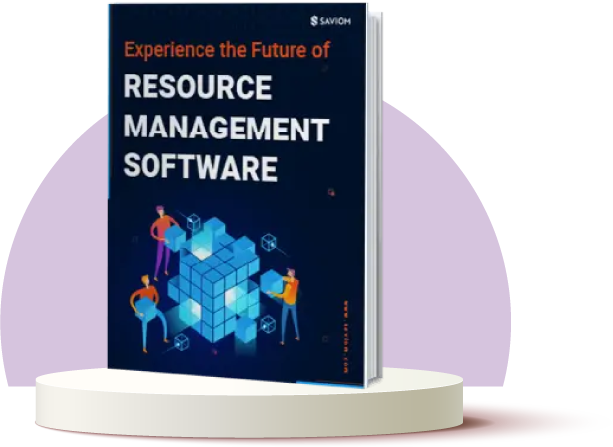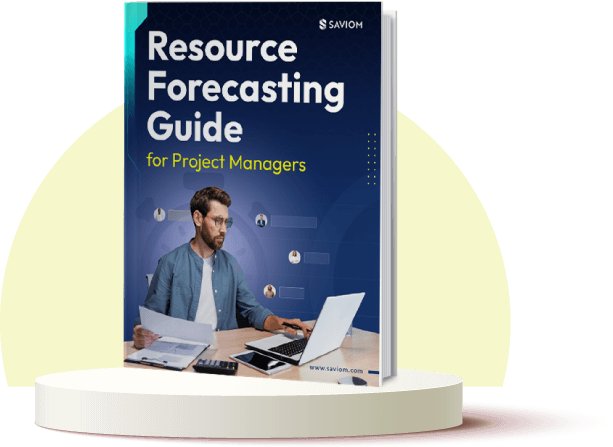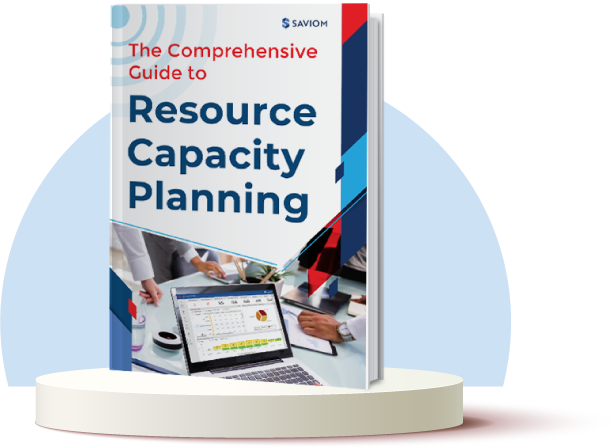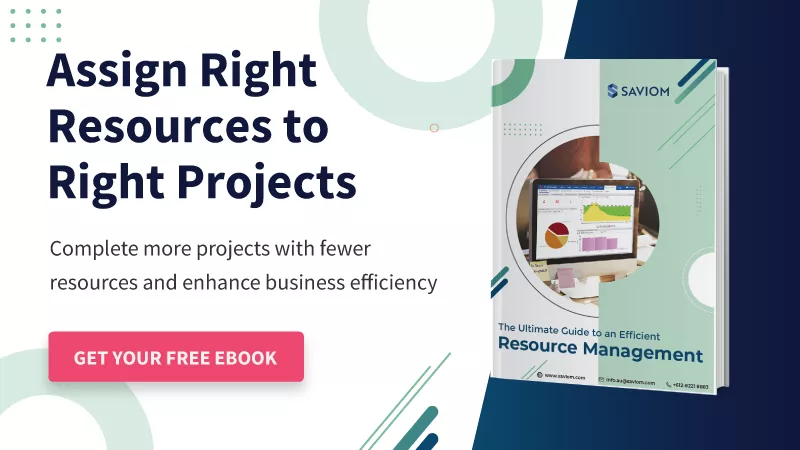Without proper tools and techniques, organizations use approximation and guesswork for forecasting, planning, and managing their resources. However, these methods fail to address growing project complexities and market volatility adequately. That’s why companies need a robust resource forecasting model to make accurate estimations, ensure timely decision-making, and futureproof the workforce.
Resource forecasting helps managers answer questions like:
- Do I have sufficient capacity and skill sets to take on additional projects?
- What should I do with the excess capacity without sufficient work to engage them?
- How can I stay within the budget with the available resource mix?
In addition, it provides actionable insights into future billable and strategic utilization, thereby boosting business profitability.
In this guide, we’ll learn the critical aspects of resource forecasting in project management.
But first, let us begin with the definition of resource forecasting.
What is Resource Forecasting?
Resource forecasting is the process of predicting project resource metrics, such as demand, supply, utilization, and costs, over a specific period of time. It provides early warnings that help businesses be proactive and implement preventive measures to avoid resource-related roadblocks and ensure successful project delivery.
A Real-World Example of Resource Forecasting: Scott Automation
Let’s consider a real-life example to understand how accurate resource forecasting can help organizations maximize business efficiency:
Scott Automation and Robotics, a leading provider of automation solutions, faced significant challenges in managing its diverse workforce across multiple countries. Their reliance on Excel spreadsheets and limited forecasting capabilities led to several challenges, including:
- Lack of real-time resource visibility
- Incompetent workforce allocation
- Insufficient insights into team utilization
However, after adopting SAVIOM’s robust forecasting and capacity planning solutions, Scott Automation can now effectively forecast 3 to 6 months’ worth of project work with precision. They could easily allocate and manage hundreds of engineers across all its offices in Australia and New Zealand.
Now, let’s go through the various forecasting techniques.
Resource Forecasting Techniques in Project Management
Listed below are some of the effective resource forecasting models that help managers in effective project resource management.
Delphi Technique
It is a technique based on the principle that forecasts (or decisions) from a structured group of individuals are more accurate than those from an unstructured group. Therefore, a panel of relevant people or SMEs is chosen to make forecasting decisions for the entire organization.
Nominal Technique
In this technique, a nominal group is formed with members having minimal interaction. The selected participants are presented with a problem and asked to write their ideas anonymously. A designated facilitator collates all the suggestions. Then, the group analyzes each idea and collectively decides on a consensus.
Brainstorming
Brainstorming is a creative forecasting technique where one finds a solution to a specific problem by capturing a list of ideas spontaneously contributed by a group. Its success depends on each member’s capacity and willingness to listen, think outside of the box, and feel free to express themselves.
Trend Analysis
Trend analysis studies past employment resource requirement patterns to predict future needs. The purpose is to identify trends that might continue. For example, an annual support maintenance contract will likely be renewed with the same terms and conditions. However, it can only provide an initial estimate.
Time Series
It involves decomposing historical data into its components: trend, seasonal, cyclical, and random variances. When the various parts of a time series are separated, the subject under study can be known over the period, and projections can be made accordingly.
Ratio Analysis
Ratio analysis is used to determine resource requirements using ratios between any causal factor and the number of employees. It assumes that productivity does not change and that the number of people required is directly proportional to parameters such as sales volume. It works better in a shop-floor environment.
Scatter Plot
It is a graphical forecasting technique that helps identify the relationship between two variables. Managerial judgment plays a significant role here. If one can forecast the level of business activity, it will be possible to estimate resource requirements. It is similar to the ratio analysis but more visual.
Now, let’s understand the importance of forecasting for businesses.
Benefits of Resource Forecasting in Project Management
Forecasting is an essential function of the resource management process, and its significance in project management is profound.
Here are the critical benefits of resource forecasting in project management:
Reduces Project Cost Significantly Across the Organization
Deloitte Global Cost Survey reveals, “Cost reduction is the most significant initiative for any business.”
Resource costs represent a substantial portion of businesses’ expenses. The most effective method to manage these costs is to leverage an advanced forecasting tool to anticipate future resource needs in advance. This helps managers identify and allocate cost-effective global professionals to minimize resourcing costs.
It also provides managers with enough lead time to implement essential resourcing strategies for cultivating an optimal resource pool for projects. Consequently, it eliminates the need for last-minute firefighting to secure competent resources and minimizes expensive hiring/firing cycles.
Read More: Reduce Resourcing Cost by 10-30% with Modern Resource Management Solution
Maximizes Resource Utilization for Billable & Strategic Work
Resource utilization is one of the most crucial KPIs for any business. However, simply engaging all the resources in various activities doesn’t ensure profitability, as they could be working on non-billable or mundane BAU tasks. Here, resource forecasting can help managers gain foresight into non-billable, billable, and strategic work ahead of time.
Therefore, it allows resource managers to improve profitability by periodically mobilizing resources from non-billable to billable and strategic projects. In addition, it helps reduce instances of under/overutilization and maintain the resource health index.
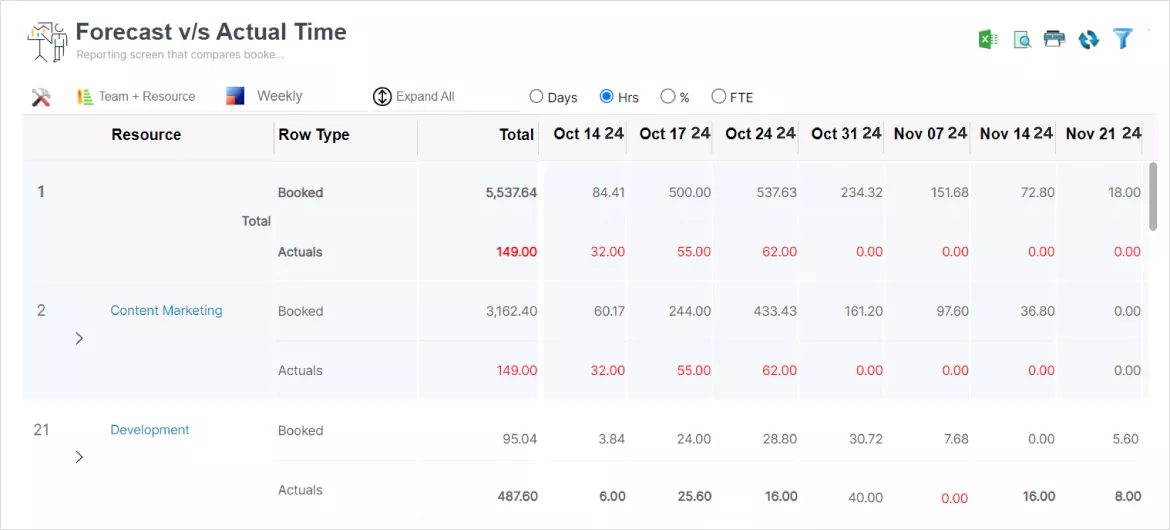
SAVIOM’s Forecast v/s Actual Time report offers valuable insights into the productivity levels of every individual.
Enables Effective Management of Pipeline Projects
Lack of visibility into the sales pipeline results in the eleventh-hour scuffling for competent resources. However, with resource forecasting, firms can proactively plan for potential projects in the opportunity or approval sales pipeline.
Foresight into pipeline opportunities enables managers to perform resource capacity planning to avoid last-minute hiring and project delays. Moreover, it reduces unnecessary cost escalation by ensuring firms have sufficient lead time to make the right hiring decisions.
Read More: 4 Steps to Perfect Your Project Pipeline Management Strategy
Controls Excesses/Shortages of Resources
An efficient resource forecasting process enables you to perform multidimensional capacity vs. demand analysis based on role, department, team, location, skills, etc. It helps identify short and long-term resource excesses or shortages and proactively bridge the capacity gap.
For instance, resource shortages can be controlled by providing training and hiring a permanent or contingent workforce. On the other hand, bringing forward project timelines or selling excess capacity mitigates the problem of excesses. Resource forecasting also minimizes bench time by providing training or shadowing opportunities.
Manages Project Financials to Stay Ahead of the Curve
Periodically monitoring critical financial indicators such as cost, overheads, revenue, and profit margins ensures the project budget is on track. In addition, you can control project resource costs in advance by comparing the actual spending against the estimated budget.
Forecasting project financials also helps you to improve future estimations and align them to reality. In addition, managers can track shared resources working on multiple projects to adjust the resource mix for increasing revenue.
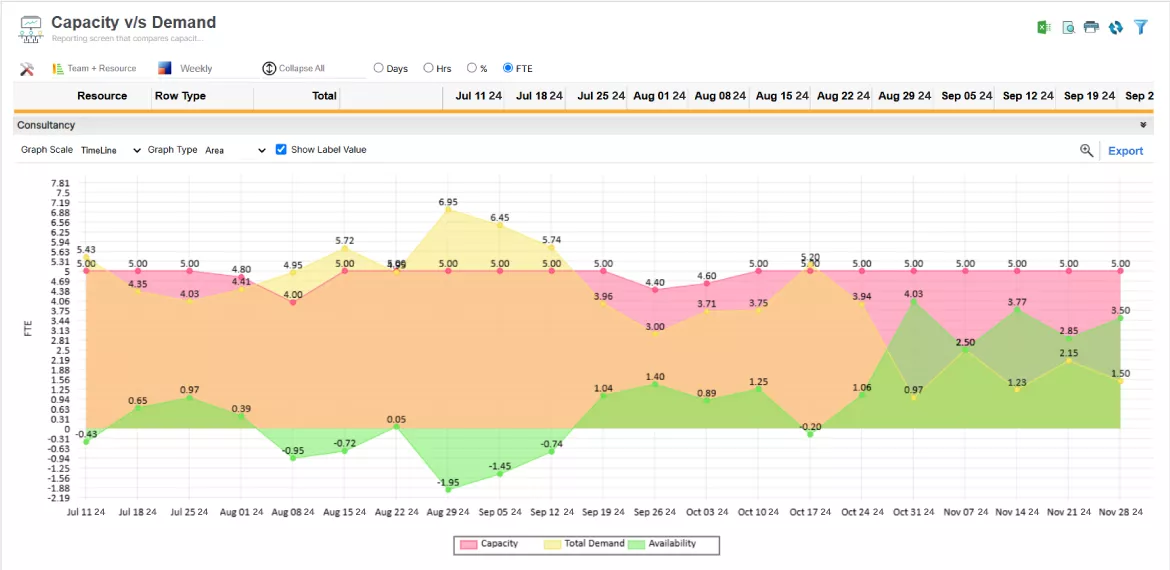
SAVIOM’s Forecast v/s Actual Cost report offers a detailed comparison of the planned budget versus actual project costs.
Reduces Benched Time of Resources
Resource forecasting enables managers to anticipate when project resources will end up on the bench after a specific date. It helps minimize bench time by proactively looking for appropriate tasks before resources are rolled off from projects.
By forecasting project vacancies, benched resources can be assigned to suitable tasks. If there are no suitable projects, managers can facilitate training or shadowing opportunities for benched resources to assign them to projects quickly and improve billability.
Now that the benefits of resource forecasting are clear let’s understand the factors that affect it.
Factors That Affect Resource Forecasting in Project Management
Resource forecasting depends on several factors, such as:
Complexity of Matrix Structure
In matrix organizations, employees work closely with people across other functions or business units and report to multiple managers. With employees working on various projects or tasks, it can be challenging to gather accurate information regarding their present and future schedules, workforce capacity, project vacancies, etc.
These complexities can undermine an organization’s forecasting accuracy. Therefore, managers struggle to set appropriate milestones, identify potential bottlenecks, and develop contingency plans to address them. Consequently, these can cause operational inefficiencies and compromise the success of the entire project.
Read More: What is Matrix Management and Why is it Important?
Project Budget Constraints
Budget constraints play a crucial role in resource forecasting, as they dictate the financial limits within which a project must operate. A tight project budget may restrict the number or type of resources deployed, leading to compromises in either quality or scope.
Thus, project managers must prioritize critical high-value tasks and strategically allocate cost-effective resources to maintain project standards without overspending. Additionally, they may foresee the resource requirements in advance and secure those resources to avoid last-minute expensive hirings and keep projects within budget.
Sudden Ramp-Up /Ramp-Down of Resources
Frequent ramp-up and ramp-down of resources within a project can affect the resource planning process. Sometimes, urgent project needs may arise with a short lead time. In such scenarios, managers can forecast last-minute project requirements and leverage an on-demand workforce or benched resources to fulfill demands.
Similarly, during ramp-down activities, managers can proactively identify when resources will be rolled off from projects and allocate them to appropriate billable or strategic work to reduce the bench size. This will ensure overall resource productivity, enhance project efficiency, and contribute to the firm’s profitability.
Read More: How to Balance Ramp-Ups and Ramp-Downs in a Project?
Emerging Technologies/Tools
There has been an explosion of new IT skills, including IoT, ML & AI, Blockchain, Big Data, and more. As a result, many existing technologies risk becoming obsolete. These technological changes mean the current workforce may require upskilling/retraining to learn new competencies & knowledge.
Therefore, it is necessary for firms to foresee and analyze emerging projects’ skill requirements as a part of the forecasting process and plan accordingly. For instance, managers can organize targeted learning and development programs to futureproof the workforce and remain competitive.
Client Requirements
Accurate resource forecasting hinges on a thorough understanding of client requirements, including project scope, timelines, budget constraints, etc. This clarity enables stakeholders to assess the resource needs for various project activities accurately.
It helps them determine the type, quantity, and quality of resources required to complete the project within the stipulated time and budget. Thus, by creating a competent and cost-effective project team, organizations ensure high-quality deliverables, meet client expectations, and minimize potential rework or delays.
Now that you’re clear about the factors that affect resource forecasting, here are some essential best practices managers should be aware of.
Resource Forecasting Best Practices
Here are some of the best practices on how to effectively forecast resources in project management:
Know the Strengths & Weaknesses of Resources Within Your Project
Resource managers must evaluate the strengths and weaknesses of each team member before assigning them tasks. This involves reviewing their past performance based on output quality, skill level, and ability to deliver on time, which is essential for successful delivery.
If a resource lacks the necessary proficiency to undertake projects, managers can initiate timely upskilling programs or hire suitable professionals to create an optimal talent pool. This ensures that the appropriately skilled resources are available prior to project execution.
Understand the Skill Requirements for Your Project to Complete Delivery
Project managers must thoroughly understand the skill sets required to deliver the project on time and within budget. By meticulously breaking down the project deliverables into a Work Breakdown Structure (WBS), managers can precisely identify the skills required to complete each task.
They can formally communicate the requirements to the resource managers. Consequently, the resource manager can take the necessary steps to ensure that the appropriate resources are allocated to the right project vacancies, facilitating a smooth project initiation and execution.
Read More: Resource Allocation: A Guide on How to Apply it to Project Management
Conduct Capacity vs. Demand Gap Analysis & Identify Skill Gaps
After understanding the requirements for pipeline projects, it is essential for resource managers to conduct a capacity vs. demand gap analysis in advance. This assessment allows them to determine the excesses or shortages of resources. In case of discrepancies, managers can implement appropriate resourcing strategies.
For excess resources, managers can bring forward project timelines or sell them at a discounted rate. Conversely, if there are shortages, they can implement an out-rotation and backfill strategy, invest in training programs, or initiate planned hiring. These practices ensure that the necessary resources are available before project onset.
Carefully Analyze Past Project Performance Data
Managers must consistently capture lessons learned throughout a project’s lifecycle. By reviewing these past performance data, managers can identify patterns and trends to refine their project management processes. This analysis allows them to understand and learn from project failures as well as their successes.
Analyzing past setbacks gives managers valuable insight into navigating future challenges and making informed decisions for future projects. Likewise, leveraging successful project outcomes allows organizations to implement improved processes to complete present and future work successfully.
Read More: Effective Strategies for Resource Estimation in Project Management
Involve All Stakeholders in the Forecasting Process
Involving and establishing direct communication with all stakeholders facilitates accurate forecasting. When a client communicates about future project requirements, the delivery team can begin preparations accordingly. Similarly, cost-saving strategies from internal stakeholders provide flexibility in optimizing the project budget.
For instance, managers may substitute their high-cost resources with more economical alternatives. This collaborative approach helps deliver value-centric services that meet and exceed client expectations. Subsequently, they can foster long-term partnerships and enhance the bottom line.
Regularly Check on the Utilization Levels of Resources
Monitoring the utilization levels of resources on a regular basis is important to maintain employee productivity levels. If resources are overutilized, managers can implement optimization techniques such as resource leveling or smoothing to re-distribute workloads or extend project timelines to prevent employee burnout.
Conversely, if resources are underutilized, they can be assigned to strategic and billable projects, ensuring they directly contribute to the organization’s growth while boosting their morale. This approach ensures optimal workforce health index, maximizes productivity, and improves ROI.
Read More: How to Track Resource Utilization?
Acquire or Release Resources as per Delivery Commitments
In project management, circumstances often arise that necessitate the acquisition or release of resources based on changing delivery commitments. It is essential for project and resource managers to develop a contingency plan that enables them to quickly fill vacant positions and maintain project momentum.
Additionally, reallocating resources provides a valuable opportunity to assess performance and potentially release underperformers once their current assignments are completed. This proactive approach helps organizations maintain a high level of productivity and business efficiency.
Keep an Eye on Industry Trends & Labor Market Conditions
Staying informed about industry trends and labor market conditions is essential for effective resource forecasting. By understanding the business landscape, organizations can anticipate changes in resource availability, skills demand, and emerging technologies that may impact their projects.
This awareness allows resource managers to adapt their strategies to attract and retain top talent. Additionally, monitoring these trends can help identify opportunities for training & development, enabling the workforce to remain competitive and aligned with industry standards, ultimately driving project success.
Now, let’s understand how a modern resource forecasting tool can help businesses.
How Can Modern Resource Forecasting Software Help Businesses?
SAVIOM’s advanced resource forecasting tool helps managers accurately forecast resource requirements for future projects.
Here’s how-
- The tool provides 360-degree visibility across firms, enabling managers to view the resource profiles, including their skill sets, competencies, cost rates, etc. This allows them to identify suitable resources for projects.
- Further, the tool’s forecasting capabilities and capacity-vs-demand report help managers to forecast and mitigate the skill gaps for upcoming pipeline projects. Thus, it reduces the last-minute firefighting.
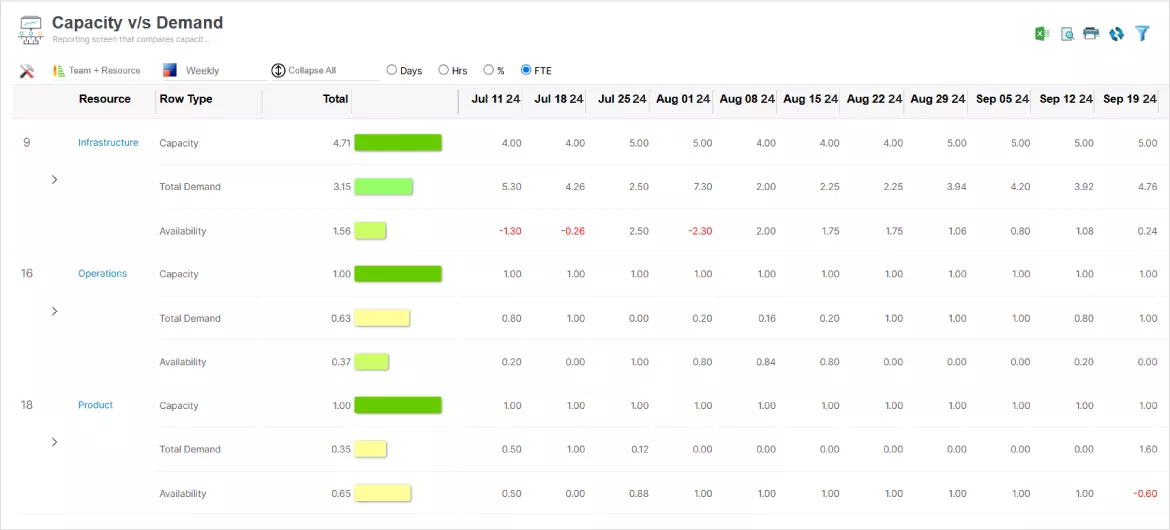
SAVIOM’s Capacity v/s Demand reporting screen helps forecast pipeline project demand and take timely resourcing decisions.
- The people-on-the-bench and project vacancy report also helps firms predict when a resource will end up on the bench, and thereby, managers can schedule them for future projects in advance and reduce the bench time of resources between projects.
- Moreover, managers can leverage the modeling and simulation functionality to analyze and compare various scenarios and their outcomes by adjusting metrics such as availability, cost rate, etc. This allows them to arrive at the most viable outcome and apply it to the actual resource plan.
Conclusion
An effective resource forecasting process enables managers to prepare for future demands by evaluating various probabilities and outcomes. By utilizing the appropriate forecasting tool, managers can generate tailored forecasts that contribute to successful project execution, ultimately boosting profitability and return on investment (ROI).
So, ready to take the necessary steps and reap the resource forecasting benefits?
Book a customized demo & streamline your resource forecasting process with SAVIOM today!
The Glossary
Read More: Glossary of Resource Workforce Planning, Scheduling and Management



